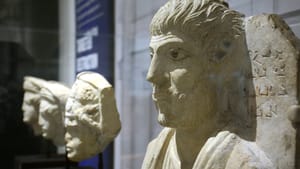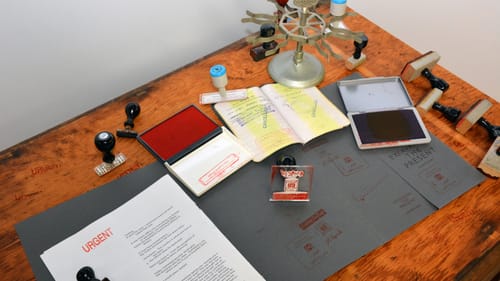Stay in the Loop
BSR publishes on a weekly schedule, with an email newsletter every Wednesday and Thursday morning. There’s no paywall, and subscribing is always free.
All is not lost
Penn Museum presents Cultures in the Crossfire: Stories from Syria and Iraq

The cradle of civilization is under siege. As refugees run for their lives, captives are beheaded, and cultural treasures are shattered, the world watches and wonders what can possibly survive. This is exactly the question addressed by Cultures in the Crossfire: Stories from Syria and Iraq, at Penn Museum.
Amid horror and heartbreak, hope
Stone heads line up stoically as if to say, “We’ve seen such savagery before and survived.” The funerary portrait heads originated in Palmyra -- a stop on the Silk Road -- and until May 2015 were one of Syria’s most popular tourist destinations.
They and other artifacts on display are products of past Penn Museum excavations. About 50 objects from the Near East and Mediterranean collections mix with rare Arabic manuscripts culled from Penn libraries, music samples, and unblinking documentary footage.
Cuneiform tablets remind visitors that this was the region that first preserved written stories for the future. In the 21st century, Penn’s Cultural Heritage Center (Penn CHC), which developed the exhibit with Penn Museum, fills a similar function, enabling people in threatened cultures to preserve their heritage. Penn CHC conducts training and research in cultural heritage and policy, marshaling archaeological, anthropological, and curatorial expertise. In this region, the effort has been dubbed the SHOSI Project (Safeguarding the Heritage Of Syria and Iraq).
SHOSI represents a sea change in archaeological priorities over recent decades. Where archaeologists once focused on bringing back finds for collections, they now prioritize excavating and conserving artifacts in partnership with, and for, the cultures that produced them.
Bombproofing vulnerable treasures
Through SHOSI, Penn supports local efforts to stabilize and protect sites such as Ebla, a Bronze Age Syrian city southwest of Aleppo known for a cache of 4,500-year-old cuneiform tablets. In Iraq, it has supported the work of architectural historian Shirin Ismail, who documents buildings in the city of Dohuk.
{photo_2}
In 2014, SHOSI organized emergency training for Syrians to protect mosaics in the heavily damaged Ma’arra Mosaic Museum. A team of experts and volunteers worked quickly, coating intact areas with a glue-like substance and cloth, reinforcing the walls with a cocoon of white sandbags. They finished in March 2015, three months before the Assad regime dropped two barrel bombs on the museum. “It worked,” said Nina Owczarek, associate conservator for Penn Museum, with a smile. “The mosaics were largely preserved.”
Head conservator Lynn Grant compares this approach to the old saying about giving a starving man a fish versus teaching him to fish: “It’s capacity-building… We work with adults and children on scene to get them documenting architecture and sites and then rebuilding or restoring them. We hope this builds appreciation of heritage for the future.”
Incorporating a Syrian perspective
In addition to drawing on resources from across the University of Pennsylvania, Cultures in the Crossfire offers artist Issam Kourbaj’s perspective. Kourbaj, born in the Syrian town of Suweida, studied at the Institute of Fine Arts in Damascus. Several of his works punctuate the exhibit.

Kourbaj lived abroad for many years, but became involved in relief efforts as soon as the violence migrated into Syria fromIraq in 2011. Though it took time for him to respond artistically, he now focuses entirely on Syria’s plight as he ponders, “What is the future of my past?”
Kourbaj’s Homeland: An Excavation (2016), a collection of immigration items on a desktop, contains the artist’s passport, a metal carousel holding official stamping devices, and the text of one of his poems, with the bittersweet line, “Homeland is not where you live if you’ve travelled there.”
Reopened artifact lab focuses on Middle East
“Ancient artifacts and modern art bring together the past and present of these two countries… what we are doing to preserve cultural heritage,” said Salam Al Kuntar, Syrian archaeologist and Penn Museum research fellow, who first suggested that Penn assist Syria. She and Penn Museum assistant curator Lauren Ristvet are the lead curators for Cultures in the Crossfire. Richard Leventhal, Penn CHC executive director, and Brian J. Daniels, principal coordinator of SHOSI, co-curated.
With the opening of Cultures in the Crossfire, Penn Museum reopens its artifact lab exhibition, which enables visitors to observe and talk with conservators as they work. The lab has expanded its focus to concentrate on Middle Eastern art and artifacts.
Considering the loss of human life in Syria and Iraq, does rescuing buildings and objects matter? In 2013, UNESCO (United Nations Educational, Scientific and Cultural Organization) provided this perspective: “The destruction of such precious heritage gravely affects the identity and history of the Syrian people and all humanity, damaging the foundations of society for many years to come. The protection of cultural heritage, both tangible and intangible, is inseparable from the protection of human lives, and should be an integral part of humanitarian and peacebuilding efforts.”
As the exhibit notes, the current strife represents only a brief moment in the region’s 5,000 years of scholarship, creativity, and innovation. We must not let the present, no matter how horrifying, diminish our appreciation of the past or hope for the future.
What, When, Where
Cultures in the Crossfire: Stories from Syria and Iraq. Through November 26, 2018, at the University of Pennsylvania Museum of Archaeology and Anthropology, 3260 South Street, Philadelphia. (215) 898-4000 or pennmuseum.org.
Sign up for our newsletter
All of the week's new articles, all in one place. Sign up for the free weekly BSR newsletters, and don't miss a conversation.